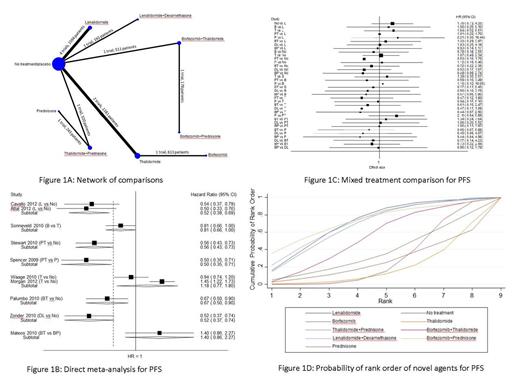Abstract
Multiple myeloma (MM) accounts for 10% of all hematological malignancies. While MM remains incurable, several life-extending treatments are available including maintenance treatments. The goal of maintenance therapy is to modulate residual MM after an initial response, thereby prolonging progression-free and overall survival by adding additional therapy following induction treatment. The role of maintenance therapies in the management of multiple myeloma is unclear and evidence on efficacy of novel regimens (e.g. bortezomib, lenalidomide, or thalidomide) remains conflicting. We performed a systematic review and network meta-analysis of trials to assess the efficacy of novel agents used as maintenance therapy in management of multiple myeloma.
A comprehensive search of MEDLINE (PubMed), the Cochrane Central Register of Controlled Trials (CENTRAL), and meeting abstracts from American Society of Hematology, American Society of Clinical Oncology, European Society for Medical Oncology and European Hematology Association was conducted to identify all phase III randomized controlled trials (RCTs) of novel agents used as maintenance therapy for multiple myeloma published until May 2013. We extracted data on overall and progression-free survival (OS, PFS). Data were pooled using direct and network meta-analysis. Direct comparisons within trials were combined with indirect evidence from other trials using the Bayesian mixed treatment comparison method under the random-effects model. Indirect comparisons were constructed from trials which have one treatment in common.
Of 2678 identified references, 23 randomized controlled trials met the inclusion criteria. Of these, 12 studies (4832 patients) contributed data to the network. The network of direct comparisons for all included studies for the outcome of PFS is shown in figure 1A. The results for meta-analysis of novel agents for PFS is shown in figure 1B. The combination of lenalidomide with prednisone was superior to no treatment as well as prednisone alone in addition to lenalidomide as single agent compared with no treatment. Furthermore, combination bortezomib plus thalidomide and dexamethasone plus lenalidomide was superior to no treatment. None of the novel agents except thalidomide plus prednisone compared with prednisone alone showed a significant improvement in OS and therefore an indirect comparison for OS was not conducted. The results of mixed treatment comparisons are illustrated in figure 1C which shows non-superiority of any novel agent. The cumulative probability rank for PFS is shown in Figure 1D. The area under the cumulative probability rank curve was highest for bortezomib+prednisone (0.73), followed by lenalidomide and lenalidomide+dexamethasone (both 0.71).
This analysis is an important addition to prior direct comparisons of novel agents for maintenance in multiple myeloma. Looking at PFS, use of bortezomib+prednisone, lenalidomide and lenalidomide+dexamethasone appears to be superior to other agents. However, provided the small number of trials between each comparison, current data do not allow for strong conclusions on superiority of any one treatment and direct comparison in a RCT is warranted for more conclusive results.
No relevant conflicts of interest to declare.
Author notes
Asterisk with author names denotes non-ASH members.


This feature is available to Subscribers Only
Sign In or Create an Account Close Modal